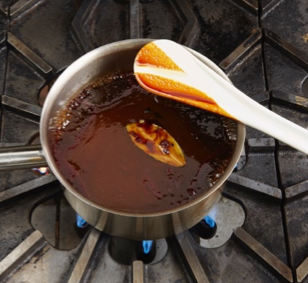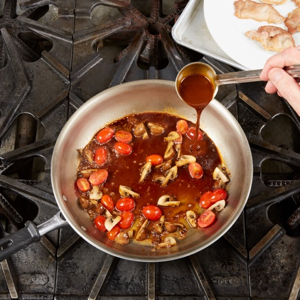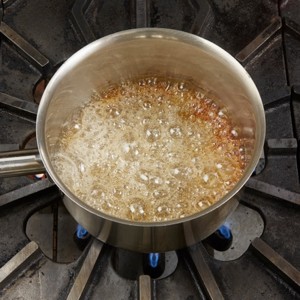Creating Small Sauces
Small sauces are traditionally created from classic sauces like demi-glace, jus lié, velouté or béchamel. They begin with infusions of aromatic vegetables, herbs, spices, and wine or other spirits. A foundational sauce like a demi-glace is added and the small sauce is cooked further to develop flavor and proper consistency. It is often finished with butter or enriched with cream or cheese. Three common methods are illustrated here. For creating small sauces to order see sautéing of proteins under the meat poultry and seafood section.
Small Sauce Prep Steps – 3 Methods Illustrated
The methods for preparing a small sauce from a mother sauce include the sauté and deglaze method, the reduction method, and the gastrique method.
Method 1 - Sauté and Deglaze Sauce Technique
This technique can be used to prepare a large quantity of sauce or for preparing smaller quantities of pan sauces after sautéing or searing cutlets or chops.
Examples: Robert, Chasseur Sauce
Step 1 - Sauté and Deglaze
Sauté the flavor base of aromatic vegetables (examples include, shallots, garlic, mushrooms, or ginger). Variations include leeks, scallions, or red onions, tomatoes, or peppers
Dried seasonings are added at this stage to allow the flavor compounds to open. Spices including peppercorns, dry mustard, curry powder, or paprika; dried herbs including thyme, bay, or tarragon
The aromatics are deglazed with wine or spirits and are simmered to concentrate the flavors.
Wine and spirit variations include dry white, red, or rosé wine, fortified wines including madeira, port, marsala, and hard spirits of cognac, brandy, vodka, gin. Other liquids include beer or hard ciders
Step 2 - Add Sauce or Flavoring Liquid
A prepared sauce of demi-glace, jus lié, béchamel, or velouté, is added at this stage
A highly-concentrated stock can be used as a substitute
Simmer to adjust the flavors, seasonings, and consistency
Step 3 – Monter au Beurre - Finishing the Sauce
Finishing a sauce with a whole butter, cream, cheese, or yogurt, enriches the flavor, balances the acidity, and provides a sheen to the appearance
Swirl in whole butter, a process known as monter au beurre, or add an egg yolk and cream liaison (Remember not to let the mixture boil or the yolks will curdle)
Method 2 – Reduction Sauce Method
This technique is similar to the sauté and deglaze method, but the sautéing step is eliminated, and the wine or spirits are combined directly with aromatics, herb, and spices.
Examples: Bordelaise, Marchand de Vin Sauce
Step 1 - Combine in a saucepan
Combine the aromatics, and seasoning, including herbs and spices, with wine or spirits, in a saucepan
The liquid is reduced through cooking and evaporation to ¾ of its original volume, or it may be cooked further to the au sec (almost dry) stage
Monter au Beurre
Step 2 - Add Sauce or Flavoring Liquid
Add a prepared sauce of demi-glace, jus lié, béchamel, velouté, or a highly-concentrated stock
Simmer to adjust the flavors, seasonings, and consistency
Step 3 – Monter au Beurre - Finishing the Sauce
Finish the sauce with cheese, crème fraiche, a liason (egg yolks and cream), or monter au beurre with diced butter
Method 3 – Gastrique Method
This technique is a sweet and sour sauce that begins by caramelizing suga and deglazing it with vinegar or sour fruits including lemons or oranges.
Examples: Bigarade, Agrodolce Sauce
Step 1 – Prepare the Gastrique
Caramelizing Sugar for a Gastrique
Start by caramelizing sugar in a saucepan
The caramel is then deglazed with vinegar, wine, and/or fruits juices to create a sweet-sour taste
Use a 2:1 ratio by volume of sugar to vinegar
Step 2 – Add Sauce/Flavoring Liquid
A prepared sauce of demi-glace is added at this stage
A highly-concentrated stock can be used as a substitute
It is simmered to adjust the flavors, seasonings, and consistency
Additional Flavors
Fortified wines (sherry, port and Madeira) are added towards the end of the cooking process because their flavors dissipate under prolonged heat
Fresh herbs and other garnishes are added at this stage
Herb Variations: Tarragon, thyme, rosemary, basil, cilantro, parsley, chives
Garnish Variations: Olives, capers, dried fruits, bacon, citrus zest, truffles, toasted nuts
Step 3 – Finishing the Sauce
Finishing a sauce with a whole butter, cream, cheese, or yogurt, enriches the flavor, balances the acidity, and provides a sheen to the appearance
Swirl in whole butter, a process known as monter au beurre
A mixture of cream and egg yolks, known as a liaison, is sometimes used to enrich white sauces and soups. Use a ratio of 4 parts cream to 1 part egg yolks. To prevent the egg yolks from curdling, never boil it after adding the liaison to the mixture
Evaluate and Adjust Flavor and Seasoning
Consider all the basic taste sensations including sweet, sour salt, bitter, and umami when looking for flavor balance in a sauce. A sauce sampled on its own should have an intense and slightly over-seasoned flavor. Remember that unlike a soup that is eaten alone, sauces must compete with other accompaniments on a finished plate.
A sauce served over a steak must match the bold flavor of the grilled meat, and any starches or vegetables.
A weak sauce, or a sauce that tastes just right when sampled alone, may easily be lost or forgotten.









